How to Advertise on LinkedIn: Tips, Strategies & Examples (2025)
Quick Links
LinkedIn is the biggest social networking site for professionals. Boasting over 792 million users, LinkedIn isn't just a place to connect with old colleagues or post from a company page. It's a valuable advertising tool to reach B2B buyers.
Studies show that over 70% of marketers see LinkedIn as a reliable source to get ROI on their advertising spend, beating Instagram, Facebook, and YouTube-likely because LinkedIn members have 2x the buying power of the average audience.
The issue: We often make advertising on LinkedIn more complex than it has to be. Whether you're facing 50 different ad sets or getting too specific with your audience, there's a lot to get wrong.
This article simplifies the basics with a step-by-step guide on how to advertise on LinkedIn, complete with examples and trends to help you build a LinkedIn ads strategy that'll stand the test of time.
What are LinkedIn ads?
LinkedIn Ads are a type of advertising campaign that lets you reach your target audience on LinkedIn. Instead of relying on organic posts (which aren't guaranteed to reach the audience you've built), you can put some budget behind your content to reach a specific group of LinkedIn users.
LinkedIn Ads work by defining a target audience. You can determine their age, job title, company, location, and interest, then customize an ad format to complete a goal-whether that's driving traffic to your website, submitting a form, or increasing brand awareness.
Types of LinkedIn ads
Sponsored content
Sponsored content appears in your target audience's LinkedIn feed. It's most similar to organic content and a popular choice if your goal is to build brand awareness. Your target audience sees the ad in a page of organic content that they're scrolling through.
LinkedIn sponsored content ads can take many forms, and here are the most common ones:
- Single image ads, which show an image beneath the text
- Carousel ads, which include more than two images that users can "swipe" through
- Video ads, which can be between three seconds and 30 minutes
- Document ads, which show an "Unlock full document" call-to-action (CTA)
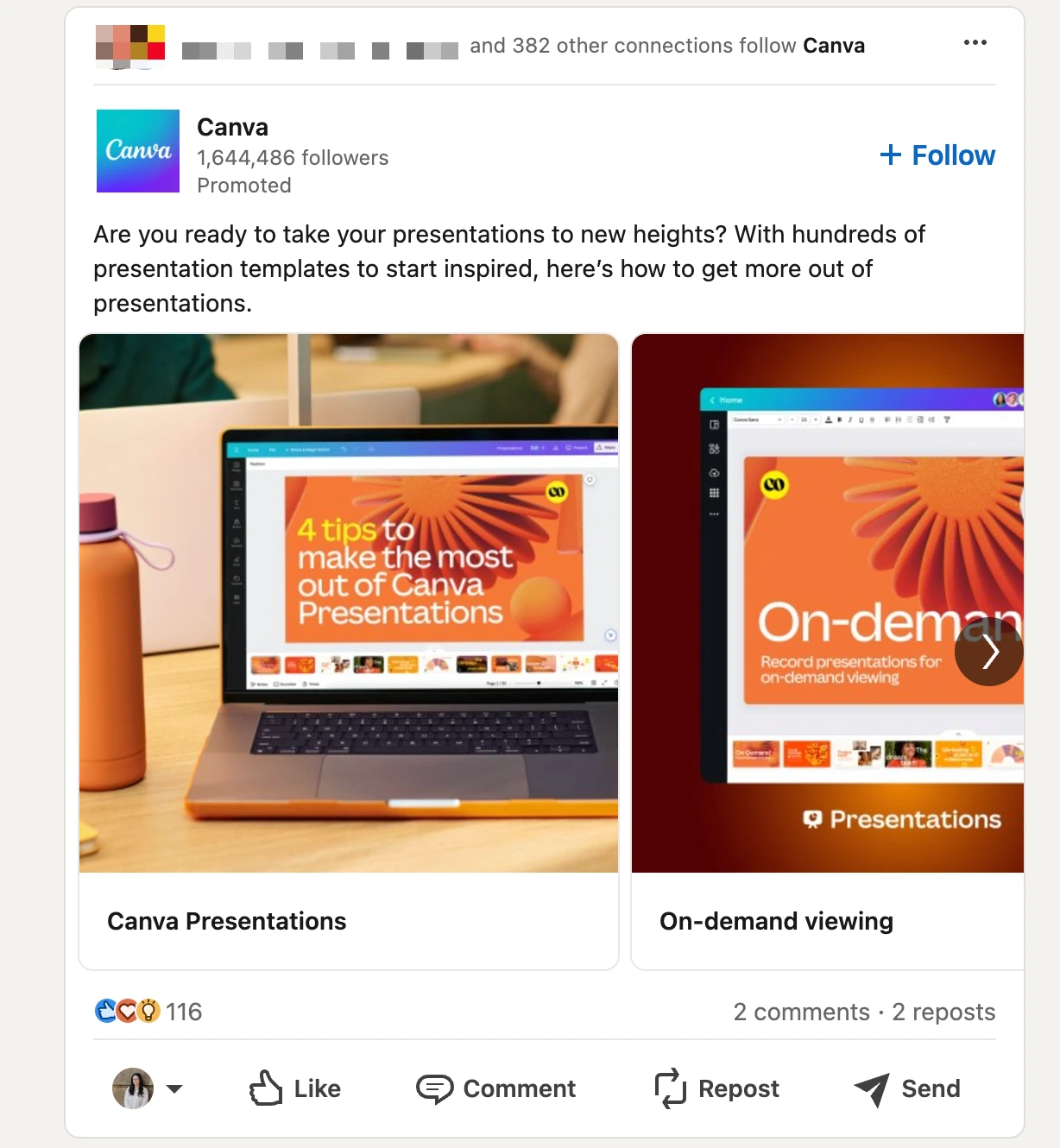
Sponsored messaging
LinkedIn sponsored messaging lets you reach out to your leads in their LinkedIn inbox.
Instead of hoping that they'll take notice of your ad in their news feed, your target audience will receive a notification of the message.
Sponsored messaging ads tend to be used for sales outreach to build your pipeline. If your buyer persona has a "Head of Marketing" role, for example, you can send a sponsored message to people with this job title on LinkedIn and encourage them to interact with your brand-whether that's inviting them to a webinar or talking about your product.
This type of LinkedIn ad has two formats that fall under the sponsored messaging category:
- LinkedIn Message Ads, a direct message to your audience
- Conversation Ads, which are chatbot-style prompts that guide the user through a conversation when they choose an option
Lead gen forms
You don't have to spend money targeting people at all stages of the funnel on LinkedIn. Oftentimes, it's cheaper to set your advertising goal as "collect emails". Once you've got a lead's information, it becomes free to retarget them through direct outreach or email marketing (as opposed to paying to reach them again on LinkedIn).
Lead gen forms are LinkedIn's way to help advertisers achieve this. It's the ideal format if the goal of your campaign is to build an email list.
Here's an example from DELLI:
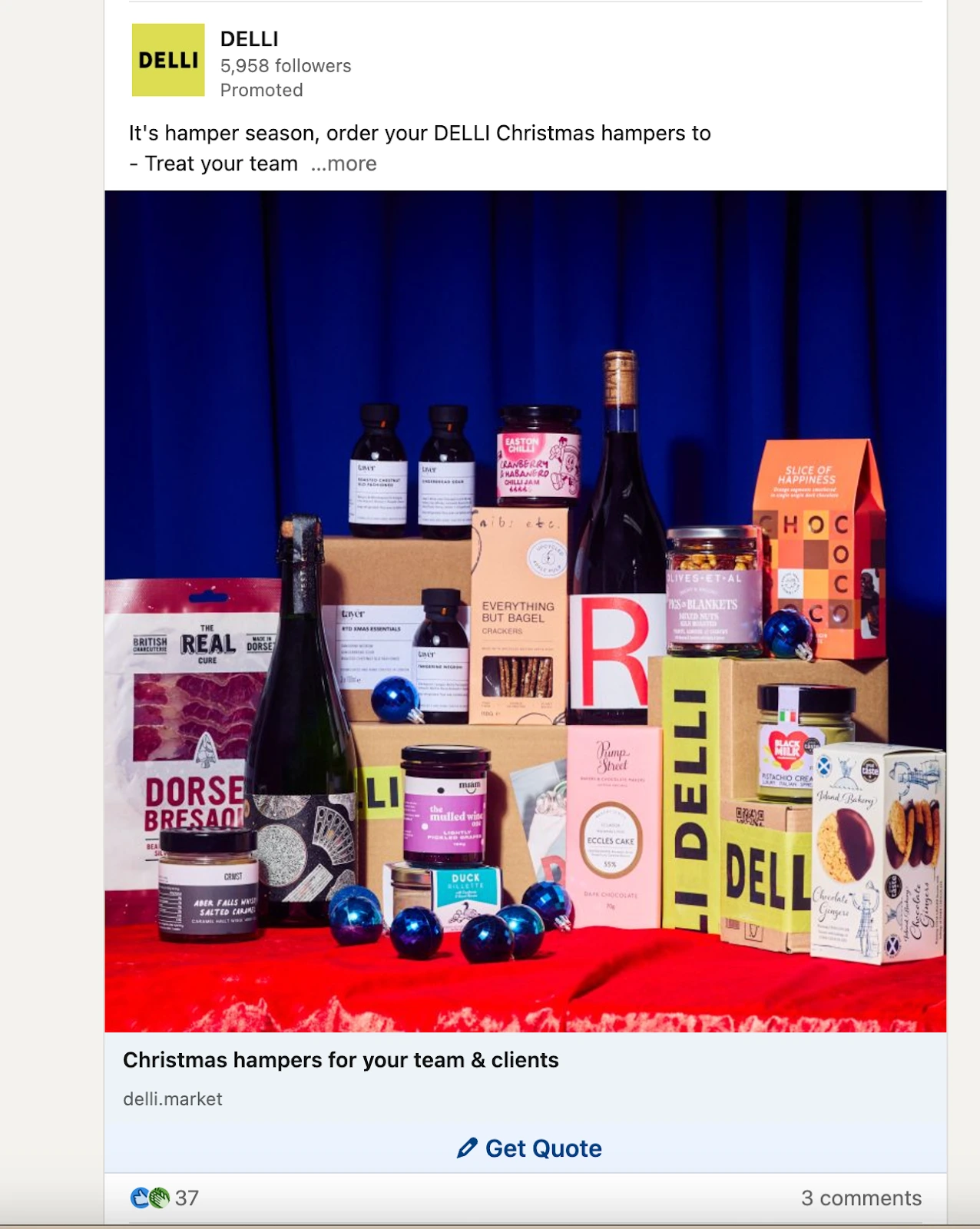
Dynamic ads
Studies have repeatedly shown that personalization works. One McKinsey report, in particular, found that personalization drives a 10% to 15% revenue lift. Apply this to your LinkedIn advertising strategy with the dynamic ads format.
Dynamic ads personalize the ad creative to each person in your audience targeting. Instead of showing the same messaging to everyone, you might address them by name or display their company name in the ad copy.
Dynamic ads always appear in the right-hand column of a user's feed. However, there are different formats you can use, depending on your campaign's goal:
- Follower Ads, which contains a "Follow" CTA button that lets people follow your company's LinkedIn page
- Spotlight Ads, which you can use to drive traffic to your website or landing page
- Job Ads, which point potential candidates towards a LinkedIn job listing
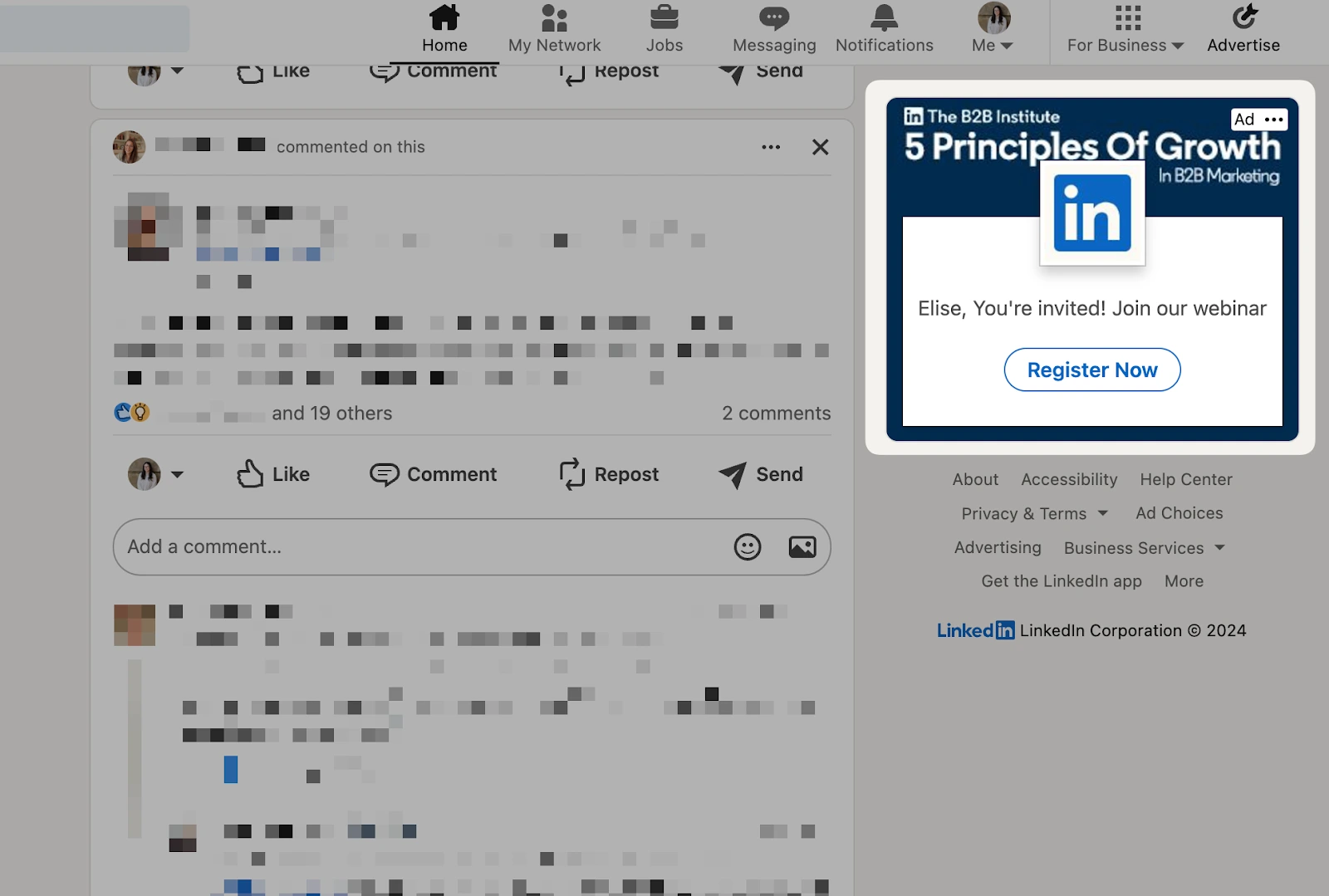
Text ads
Text ads appear in the top-right corner of the LinkedIn feed. They take up the smallest amount of space in a user's feed, and are usually grouped into a stack of three. They tend to be cheaper than other campaigns.
"Three times this week, I've received DMs from people who have seen my text ads and complimented me on how I used them," said Fibbler's CEO Adam Holmgren. "And most importantly, they are basically free impressions. Why? Because most people don't click on them. But you can still tell part of your story and get your brand in front of them."
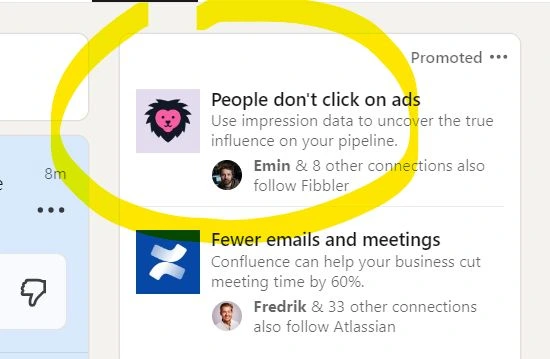
How to advertise on LinkedIn in 7 steps
1. Set up the LinkedIn Campaign Manager
The LinkedIn Campaign Manager is where you'll manage your LinkedIn ads. Sign into your personal account, locate the Campaign Manager, and follow the instructions to set up your account.
You'll need the following information to hand:
- Account name
- Company's LinkedIn page you want to advertise from
- Currency preferences
Once you've created your account, now's a great time to install the LinkedIn Insight Tag.
Similar to the Facebook Pixel, you'll install this Javascript-based code to install on your website. It collects data on website visitors who came from LinkedIn ads and allows you to track conversions, retarget website visitors, and build audience lists.
To install the LinkedIn Insight Tag:
- Sign into LinkedIn Campaign Manager
- Find Analyze in your left-hand navigation bar
- Choose Signals manager
- Click Create Insight Tag
- Copy and paste the JavaScript code into the <head> section of your website
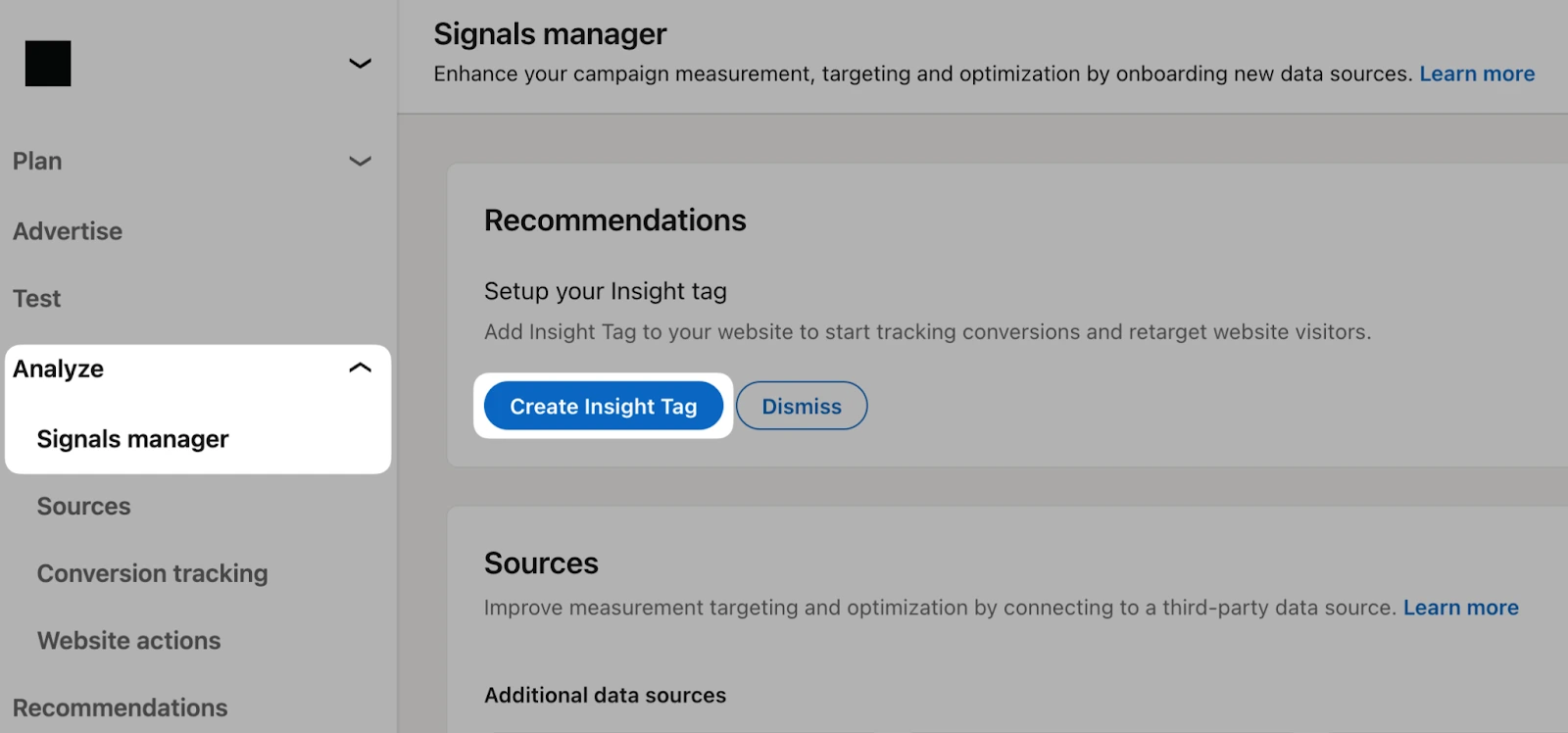
2. Choose an ad objective
Next, choose the goal you want to achieve with your LinkedIn ads campaign. These are grouped by stage of the funnel:
- Awareness (brand awareness)
- Consideration (website visits, engagement, video views)
- Conversions (lead gen, website conversions, job applications)
Your ad objective influences how your budget is spent, and who the campaign is displayed to. In other words: LinkedIn's algorithm optimizes for what matters most to your business.
If your goal is to generate leads for example, the "Lead Generation" objective means LinkedIn will prioritize users who are more likely to complete a form.
Each objective also tracks different performance metrics. Awareness is monitored by impressions, reach and engagement, whereas consideration and conversions track metrics like form downloads, website clicks, and sales.
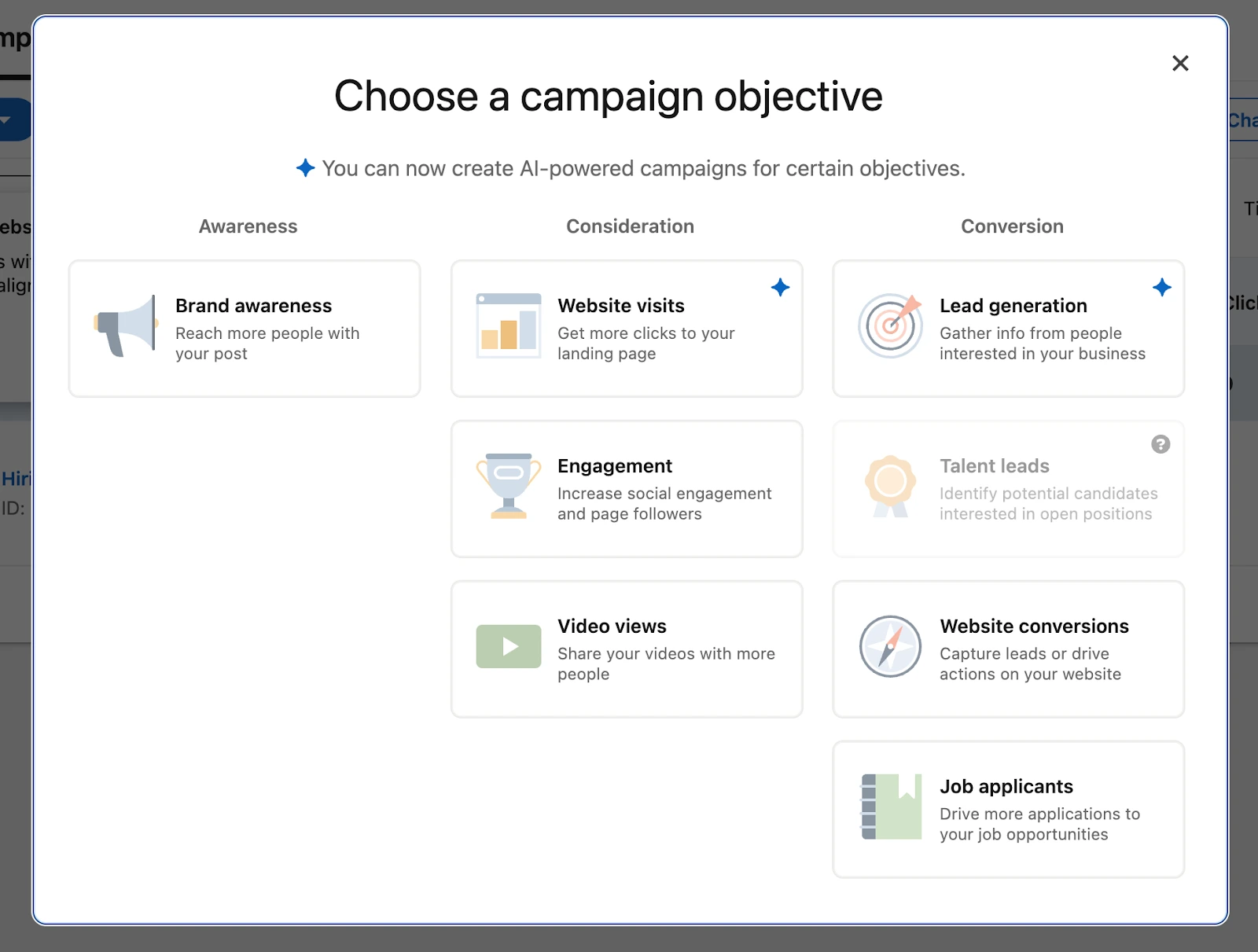
3. Set a budget, schedule, and bid type
The next step of the ad creation process is to determine how you'll pay for your campaign. You've got two choices:
- Daily budget (minimum $10/day), where your budget is distributed across each day of the campaign. If your campaign runs for multiple days, the algorithm will try to spend the daily budget evenly. It will try to avoid overspending across the full campaign duration. The daily budget is ideal if you want more control over your ad spend and to maintain a steady flow of impressions.
- Lifetime budget (minimum $100), where you specify how much you'd like to spend over the entire campaign. LinkedIn will aim to spend your total budget evenly, but spend may fluctuate slightly from day to day depending on the performance and auction dynamics.
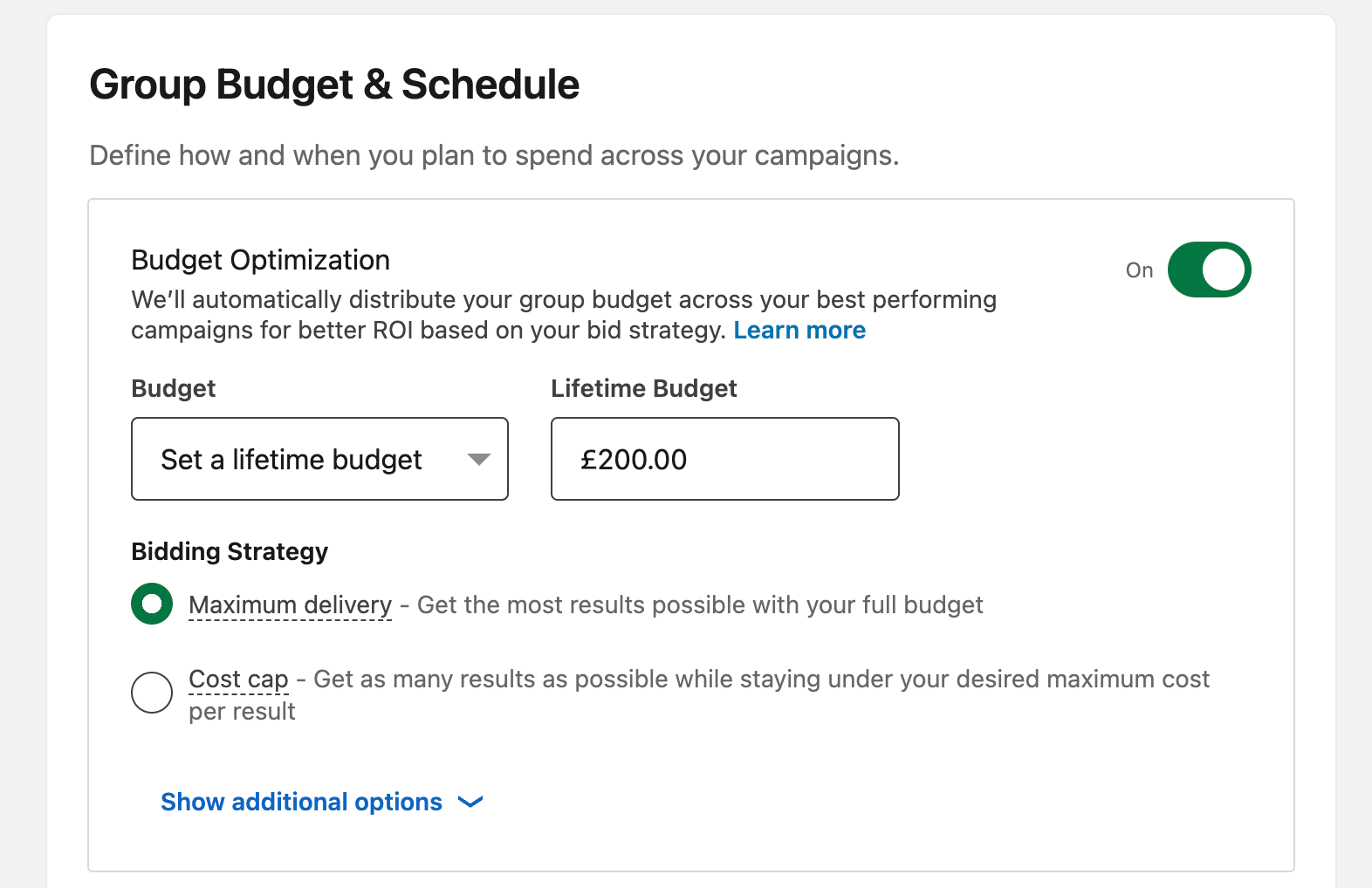
LinkedIn determines the cost of a campaign by placing your ad in an action.
The highest bid wins the advertising placement, but you can customize your bidding strategy to specify how much you're willing to pay for a specific action (e.g., a click, an impression, or a conversion).
There are three options to choose from:
- Max delivery, which adjusts your bid to get most results using your full budget
- Target cost, which aims to get the most results while staying as close to your bid budget as possible
- Manual bidding, where you control how much you pay in the ad auction
We recommend using manual bidding and setting the bid at about a third of the recommended bid. You will most likely not lose any ad performance, but your budget will be spent much more efficiently.
⚡ ️Pro tip: Avoid wasting budget by showing LinkedIn ads when your target audience is offline. Fibbler lets you schedule ad campaigns in order to use your budget when an audience is most active (such as weekdays only). This feature isn't available in the LinkedIn Ads platform-it's always set to run the entire time.
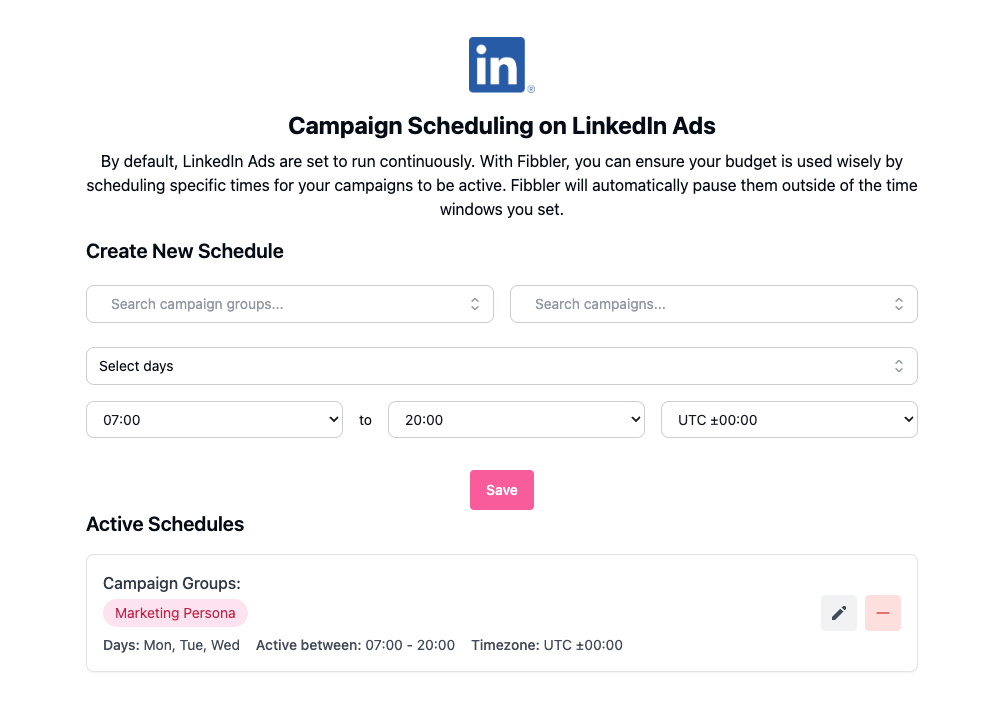
4. Define your target audience
LinkedIn's audience targeting feature allows you to get super specific with who you want to reach with your campaign.
Treat it as a way to replicate your ideal customer profile (ICP) or buyer persona. Include audience attributes such as:
- Location
- Demographics (age and gender)
- Education (degrees, fields of study, or member schools)
- Job experience
- Interests and traits
Alternatively, use tools like Vainu to build custom targeting lists-they offer more granular filters to surface B2B businesses that match your ICP criteria than LinkedIn can offer. "You have to use a company list as your have to use a company list as your main targeting source," advises Adam Holmgren. "Segment your ideal customer profile (ICP) from any third-party solution out there and push it straight into LinkedIn."
⚡️Pro tip: Remember to exclude existing customers and competitors from your campaigns. This avoids wasted budget by displaying your ads to them.
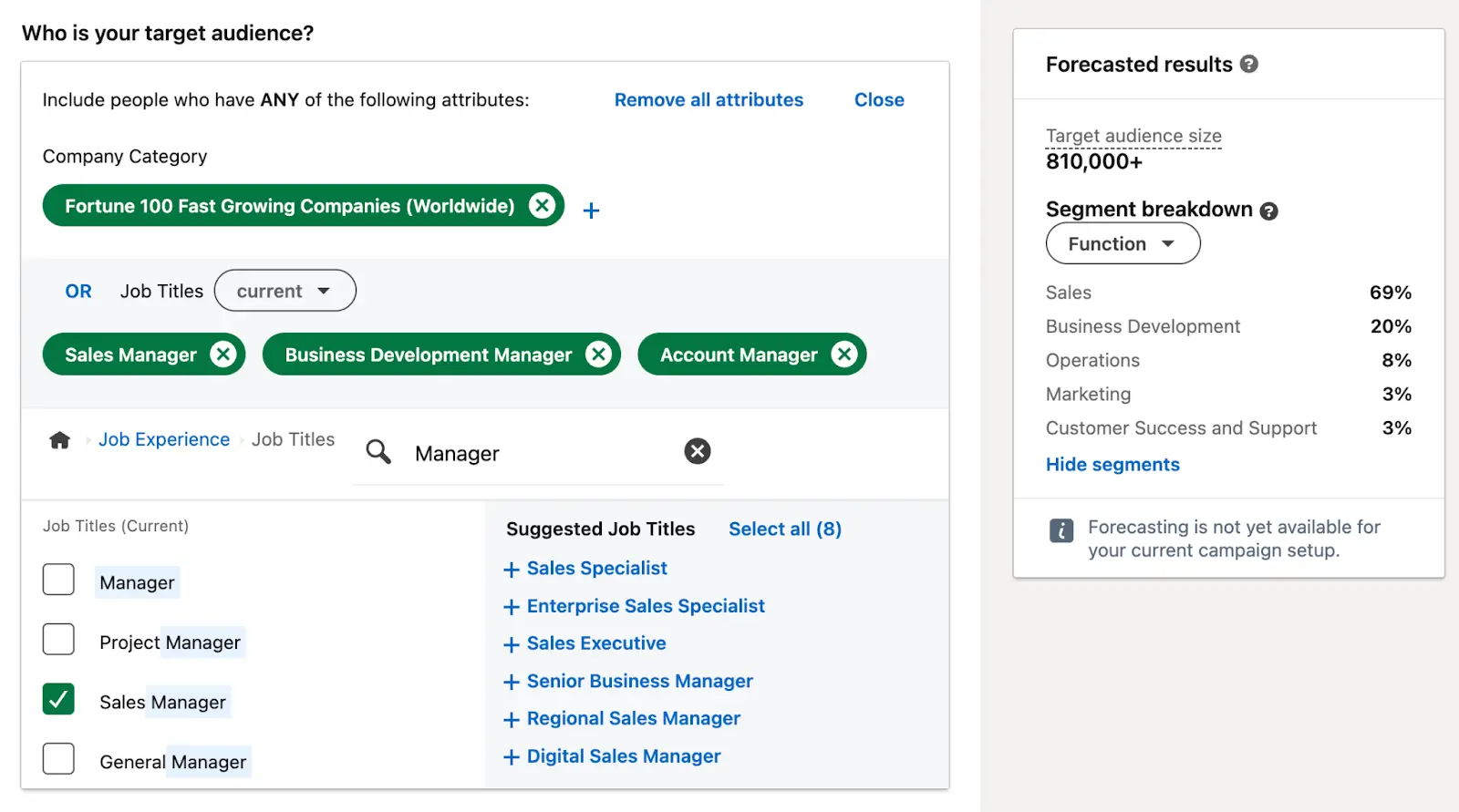
What's especially great about LinkedIn is that you can run campaigns to a few companies only. It's ideal if leads have a long sales cycle and multiple stakeholders are involved in the decision-making process.
Configure your LinkedIn audience targeting to specify people who work at those companies, and personalize the ad content accordingly. Just bear in mind that you must target at least 300 members if you're uploading a custom list, or 1,000 members if you're using LinkedIn's targeting feature.
"If you are doing account-based marketing, Linkedin is the place to be," says Paula Glynn, director of search marketing and digital strategy at Pixelstorm. "We are working with a HR company and just starting using this feature to target their ideal customer. As in, a whole campaign around targeting that company.
5. Design your LinkedIn ad creative
As we touched on earlier, LinkedIn supports a variety of ad formats. Now's the time to get creative and customize what your target audience sees.
LinkedIn's own data shows that audiences who are exposed to different ad formats are 6x more likely to convert. Play around with carousel, image, video, and thought leadership ads to keep the audience experience fresh.
You can also create multiple versions of each ad format. Experiment with:
- CTA copy
- Headline copy
- The product benefit you're discussing
- Social proof (customer reviews, 5* ratings, etc.)
- Images
- Video length
- Ad placements
⚡️Pro tip: Get a thorough understanding of your target audience before you finalize this step. You should know what makes them tick, the problems they're solving, and the language they use-all of which you can reflect in your ad creative and grab their attention.
"If you are running ads targeting a persona that's not your own, you MUST spend a significant amount of time researching and truly understanding their day-to-day activities," says Adam Holmgren. "Join sales calls, listen to sales calls, conduct interviews, etc. This is CRITICAL before even considering running ads."
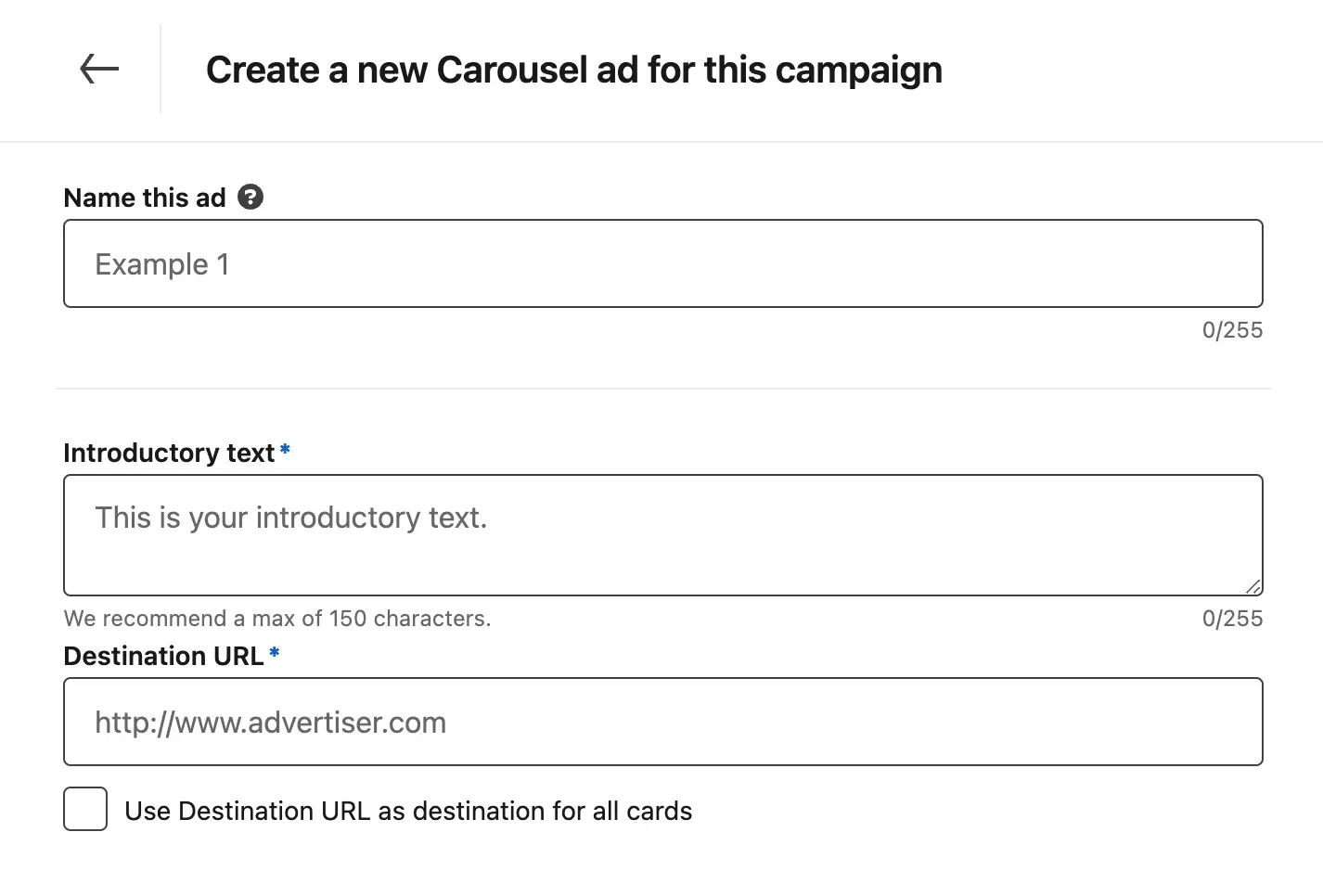
6. Launch your LinkedIn Ads campaign
Before you submit your campaign and go live, do one final review. Check that your target audience is spot on; your creatives don't contain spelling mistakes; and that you've matched the right copy with the visual.
Once you're happy, press Submit. Your campaign will go to LinkedIn to review your ad before it goes live. This can take up to 24 hours, though is often quicker. You'll get a notification when it's approved.
7. Measure and improve your campaign performance
It takes around two weeks to get substantial data to measure campaign performance.
At this point, you might notice that clicks are low. This is normal. As SaaS growth and marketing advisor Sophie Michaud explains, "Keep in mind that many people don't click ads. But that doesn't mean they're not working."
"I look at dwell time to see if people actually read through a post, or watched a video fully. And even if they didn't click to the website, next time they see an ad from the same company, they'll remember." company, they'll remember."
Measuring ad performance requires different measurements than just click-through attribution. That's where Fibbler comes in. It ties ad impressions to CRM data (such as pipeline and revenue) for accurate measurement.
"We got Fibbler up and running in less than a day and it's already syncing our LinkedIn Impressions data straight into HubSpot. It has really helped our marketing and sales teams get a clearer picture of how our demand generation efforts are impacting the pipeline. Absolutely love both the product and the price!" -Alen Todorov, Head of Marketing @SEOmonitor.com
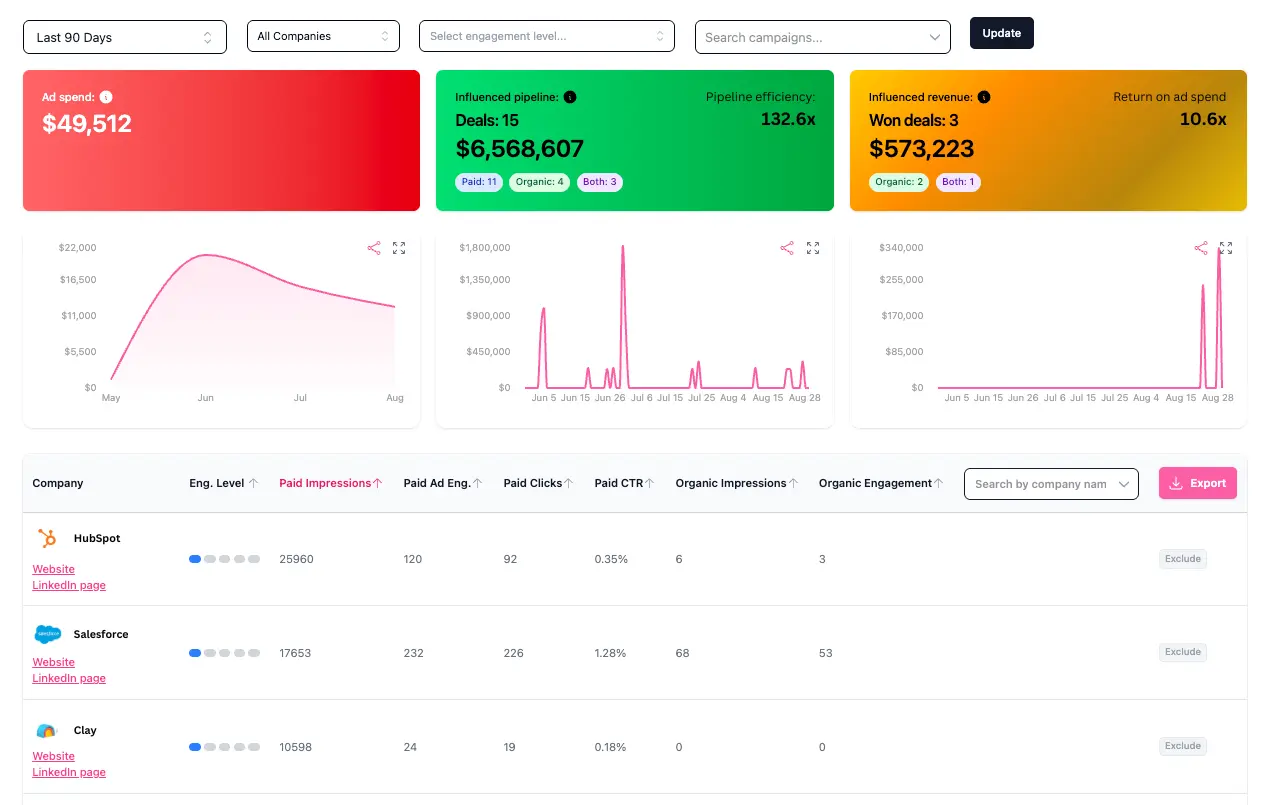
Best practices to optimize LinkedIn Ads ROI
Map LinkedIn ads to the sales funnel
Best practice is usually to map content to each stage of the funnel. Those at the top should get generic brand awareness ads, those in the middle directed to a webinar, and those at the end with a sponsored message to encourage a product demo registration.
Yet the truth is: in B2B advertising, we have no idea at what stage our audience is. Just because a lead clicked your webinar registration form, it doesn't mean that they're nearing the end of the sales funnel. Perhaps they just needed to add the link to their calendar.
This is why it's so important to have content that can engage anyone at any stage.
Instead of dividing your audience by their stage of the funnel and specializing your content accordingly, Adam Holmgren recommends people into a cold layer. He assigns 60% of the total budget to these campaigns.
"The purpose of this layer is quite simple: to funnel people into our retargeting layer in order to paint the full story at a higher frequency," Adam says. "I like to run two main campaigns, with objectives for website visits and video views, utilizing both image and video ads." both image and video ads."
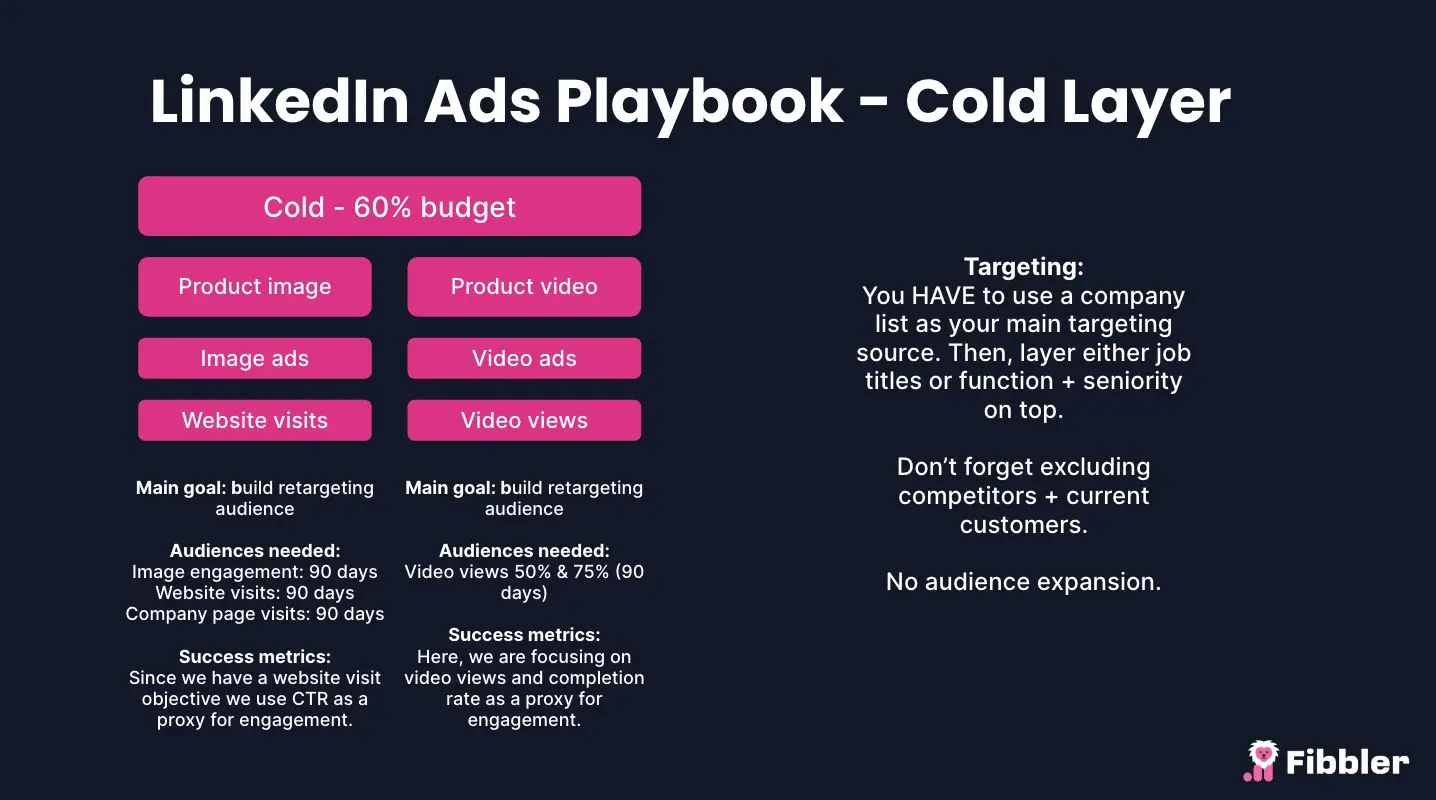
Retarget audience lists
The second layer in the LinkedIn ads funnel is to retarget people who've already interacted with your brand. This is where the remaining 40% of your campaign budget goes.
Adam does this by retargeting people from the cold layer in the last 90 days who have:
- Engaged with a video
- Clicked the website link
- Visited the company's LinkedIn page
- Watched at least 50% of a LinkedIn video ad
But you could expand these retargeting lists using data sources like:
- Website analytics: people who've visited a specific page, spent a certain duration of time on-site, etc.
- Customer lists: people who've bought specific products, spent a certain amount, redeemed a specific promotion, etc.
Retargeting is effective because by this point, your audience already has some understanding of who you are, what you sell, and how you can help them.
JD Garcia, Head of RevOps and Strategy at Impactable also recommends this approach: "Add the LinkedIn pixel to your site, gather your first-party data, and start marketing to people who meet your ICP criteria and are already familiar with your brand." your brand."
"LinkedIn is expensive, so it's best to start with warmer audiences (when possible) before jumping into the cold (water) layer," JD adds.
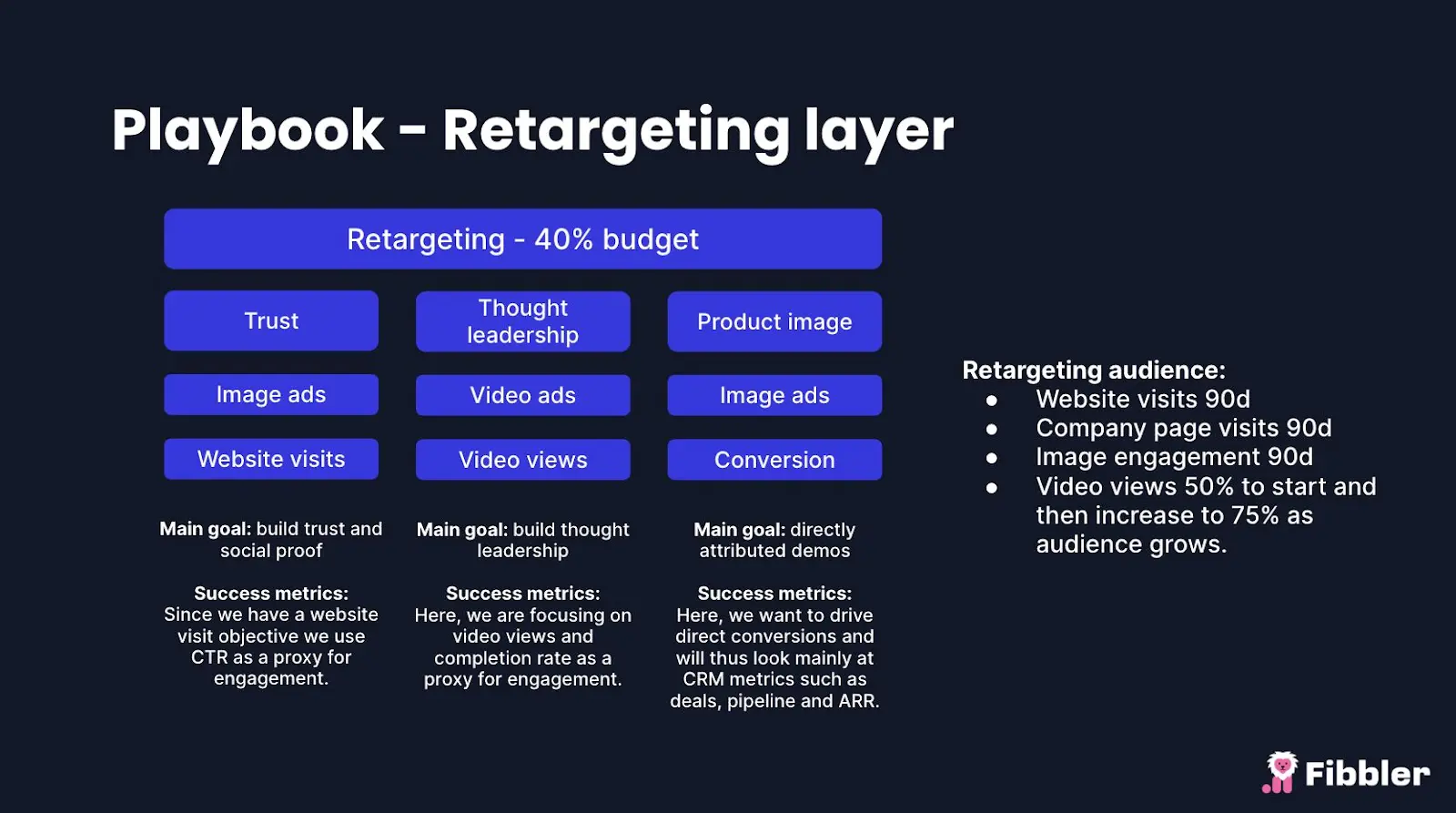
Run A/B tests
The first iteration of your LinkedIn advertising campaign likely won't be the one that best engages your audience. It takes trial and error to see what works (and what doesn't).
LinkedIn has its own A/B testing feature to help advertisers find the format, creative, messaging, and goal that achieves your goal in the most cost-effective way. For example, you could run an A/B test to figure out:
- Whether it's cheaper to drive traffic with text ads vs. sponsored messaging ads
- If text posts with emojis get more engagement than those without
- Whether more people register for a webinar if it's labelled as "free"
Bear in mind that A/B testing isn't a short-term strategy. LinkedIn recommends that your A/B tests run for at least two weeks to draw meaningful conclusions, but you might need to extend the timeframe if your audience size is small.
The more data you have, the quicker (and more accurately) you can prove statistical significance.
"A B2B market is educated; to get the creative right takes time," adds Paula Glynn. "Test until you work out what is right for your audience. It's highly visual and needs to cut through the feed."
Turn organic posts into thought leadership ads
A/B testing is a great way to experiment with campaign messaging and formats. But what happens if you don't have the time to wait for the experiment's results, or the money to spend on multiple tests?
Instead of spending money to see what works, test it for free on your existing LinkedIn audience. The control group is much smaller, but it has a unique advantage.
Boosting organic posts with high engagement can get someone's attention more than an ad with minimal likes or comments. It acts as another seal of social proof that you're liked and trusted by your target audience's peers.
"I select my most engaging organic posts each month and incorporate them into this framework." -Adam Holmgren, CEO of Fibbler
Match campaign results to your CRM data
Changes to cookie tracking policies mean it's harder than ever to attribute sales to a particular campaign. If a user declines first-party cookies when they visit your website, for example, you can't attribute their on-site activity to a LinkedIn ad.
LinkedIn ads also tend to get a low number of clicks, therefore your campaign doesn't get the credit for any action that happens off the back of your campaign on external channels (i.e. your website). But Fibbler shows you if people have viewed ads before something happens-like registering for your advertised webinar-so you can attribute their activity to a LinkedIn ad.
"Attribution shouldn't be an expensive dream," says Eduardo Casado, head of marketing at Mouseflow. "I rely on Fibbler to surface the real extent of my campaigns reach and how much they influenced our pipeline."
What is Fibbler?
How much do LinkedIn ads cost?
LinkedIn determines its advertising costs on a few factors: who you're targeting, the bidding strategy you've chosen, your campaign objective, and how relevant it is to your audience.
Generally speaking, here's how much you can expect to pay for LinkedIn ads:
- Average cost per click (CPC): $2 - $3
- Average cost per mile (CPM): $5.01 - $8
- Average cost per send: $0.26 - $0.50
The future of LinkedIn ads in 2025
Thought leader ads
Employee-generated content humanizes brands by showing the people who work there, as opposed to being a faceless corporation. People like to do business with people.
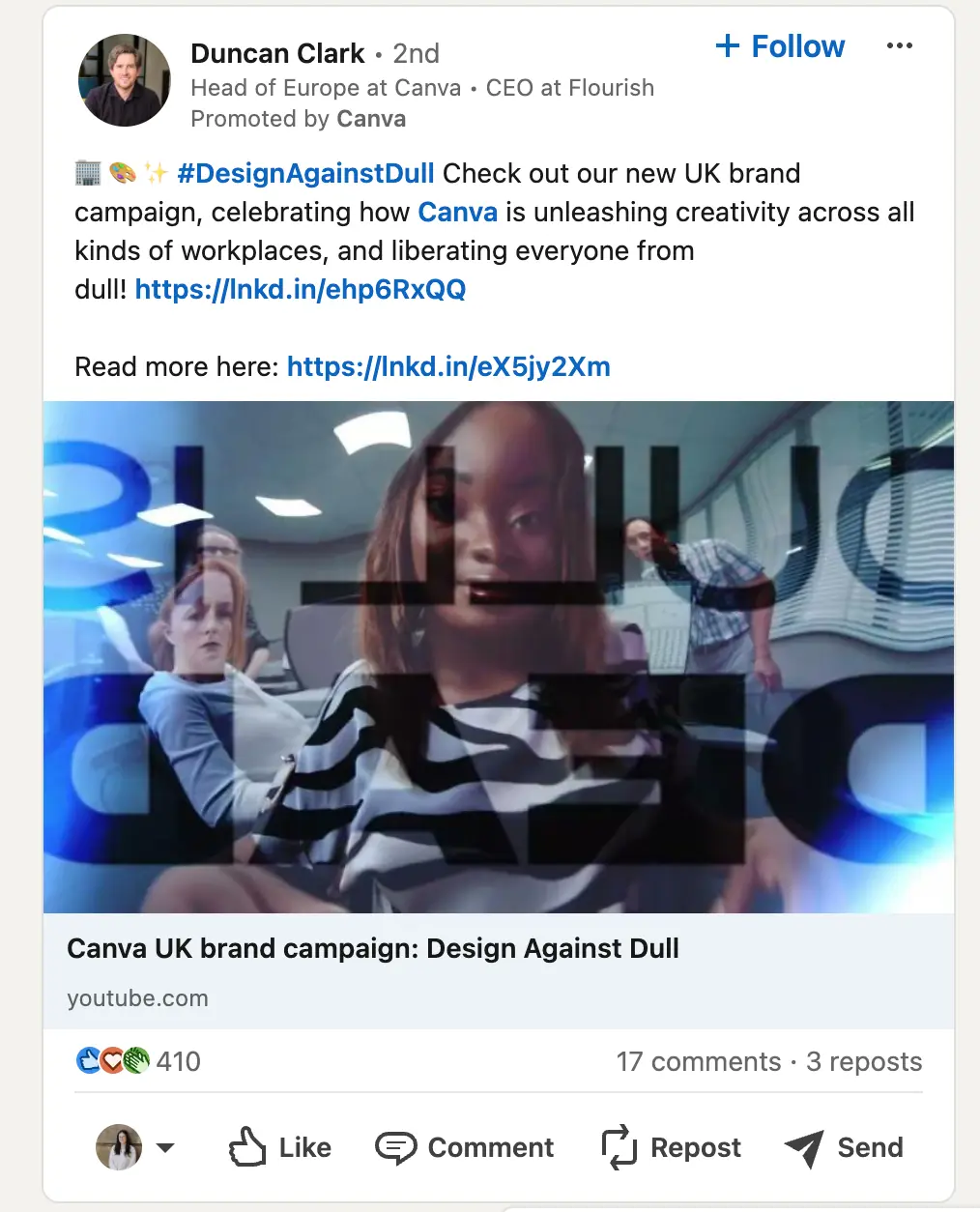
Sponsored user-generated content
It's not just employees that you can use to humanize your LinkedIn campaigns.
The B2B influencer space is growing, which presents a unique opportunity for B2B brands: Find customers who have their own LinkedIn followings, or work with creators who can produce UGC videos, to sponsor. The ad can appear from their profile to look unbiased and leverage their name.
"Recently, LinkedIn launched ads from personal accounts. So companies could use their leadership and employee content in ads directly. I'm expecting this to expand to external influencers both with text ads and vertical video, where content can be in partnership and co-shared." -Sophie Michaud
Instantly.ai does this with LinkedIn influencer Sander Aavik. He posted a glowing review of how he used the brand's software to improve email marketing results-a great technique that proved the brand's value without shouting about it themselves.
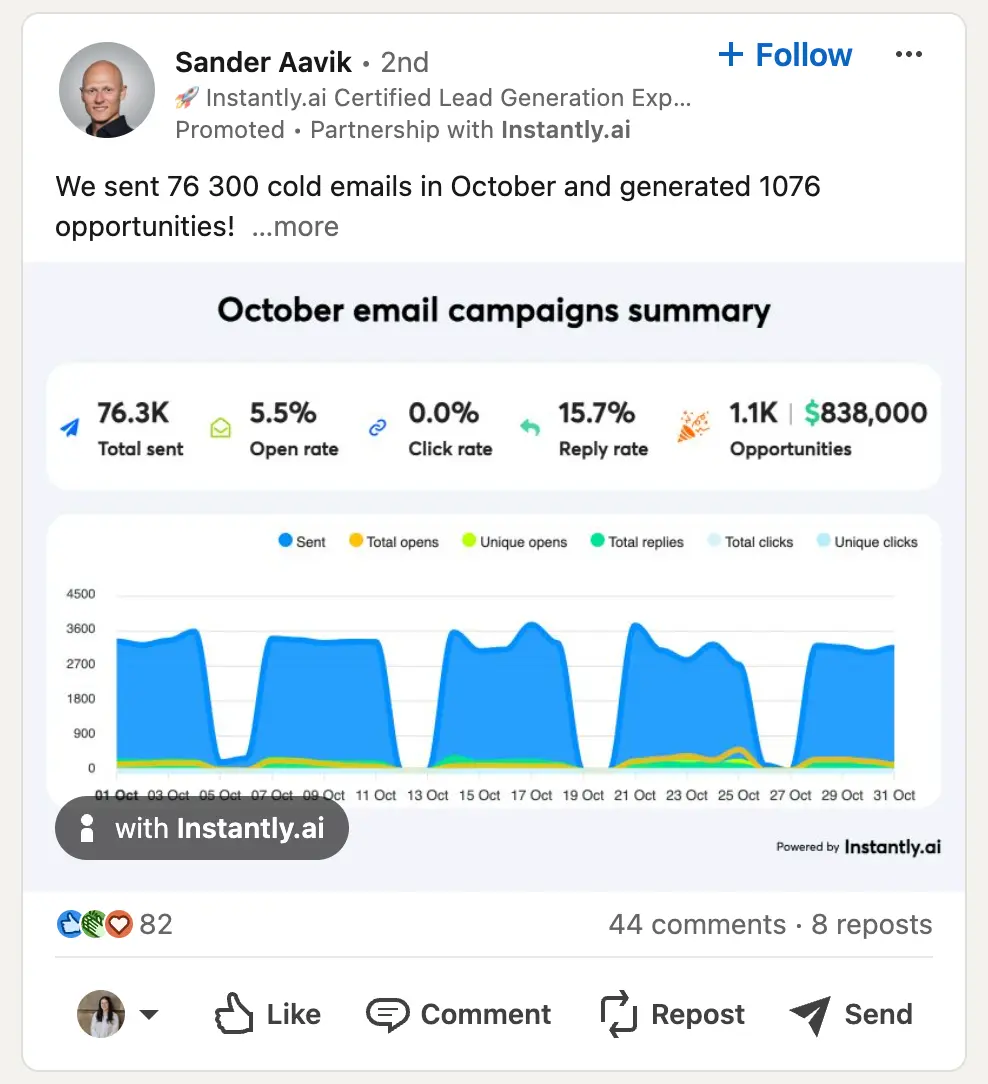
Truly creative ads
We see up to 10,000 advertisements every day. Ad fatigue is rife-some 64% of people actively try to avoid seeing ads in podcasts, social media news feeds, and websites they're browsing. It takes something truly unique to stand out. browsing. It takes something truly unique to stand out.
Exactly what "creative" looks like can depend on your industry. For example, you could:
- Give something away for free. Whether it's a free product demo or a small sample of your products, the word "free" implies that there's no strings attached. LinkedIn users don't have to make a big commitment when they engage with your campaign.
- Take a stance. If your target audience is concerned about sustainability, for example, call this out in your campaign to connect with buyers on something they're passionate about. More than half of consumers say their relationship with a brand starts when they feel the brand understands them and their desires.
Match LinkedIn ads with CRM data using Fibbler
LinkedIn Ads are a valuable tool to reach B2B audiences. The issue most marketers run into, however, is uncovering the results of their campaign. People rarely click LinkedIn ads when they see them in their news feed, making it difficult to monitor ROI.
Fibbler helps you understand how LinkedIn Ads impressions influence your pipeline and revenue, while turning engagement data into actionable intent signals for your ABM program. See exactly who viewed your LinkedIn ads, with a timeline for each company you're targeting-without spending a fortune on attribution or ABM software.
LinkedIn advertising FAQs
What is a LinkedIn ad campaign?
A LinkedIn ad campaign is a way for marketers to reach their target audience on LinkedIn. Instead of posting organically, a LinkedIn ad campaign has a budget behind it. You can also get specific with who your ads show to.
How do I use LinkedIn for ads?
- Open the LinkedIn Campaign Manager
- Choose a campaign objective
- Configure your target audience
- Choose a schedule
- Set an advertising budget
- Select your ad format and placement
- Build your ad creative
- Preview and launch the LinkedIn ads
What is the minimum budget for LinkedIn ads?
LinkedIn has a minimum daily budget of $10 which applies to all campaign types and ad formats. If you're using a lifetime schedule for a new inactive campaign, a minimum budget of $100 applies.
Are LinkedIn ad campaigns worth it?
LinkedIn is a great platform to advertise on if you're targeting B2B audiences. It has the largest network of professionals in the world, and offers a range of ad formats and targeting features to reach your audience-regardless of your goal.
Written by

Adam Holmgren
CEO @ Fibbler

See the real impact of your LinkedIn Ads
Fibbler connects your ads data to your CRM so you can see which companies your ads influence and give your execs proof that LinkedIn drives revenue.
Try 30 days for free
See the real impact of your LinkedIn Ads
Fibbler connects your ads data to your CRM so you can see which companies your ads influence and give your execs proof that LinkedIn drives revenue.
Try 30 days for free